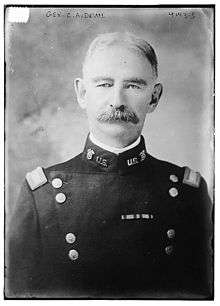Carroll Augustine Devol
Carroll Augustine Devol (April 17, 1859 - June 3, 1930) was a major general in the United States Army who took his own life in 1930.[1]
Carroll Augustine Devol | |
|---|---|
 | |
| Born | April 17, 1859 Waterford, Ohio |
| Died | June 3, 1930 (aged 71) Redwood City, California |
| Allegiance | |
| Branch | United States Army |
| Rank | |
| Unit | 25th Infantry Regiment |
Biography
He was born on April 17, 1859 in Waterford, Ohio to Hiram Fosdick Devol (1831-1912) and Adelaide Amanda Dyar (1837-1860). He married Dora Scott Devol (1861-1950). Their daughter, Mary Devol, married George H. Brett on 1 March 1916.
He was a second lieutenant for the 25th Infantry Regiment on September 1, 1879; first lieutenant on October 19, 1886; regimental quartermaster April 1, 1887 to April 19, 1891.
In 1895 he was a professor of Military Science and Tactics at the University of Wisconsin.[2]
He was captain assistant quartermaster August 21, 1896; major quartermaster volunteers October 17, 1898; lieutenant colonel quartermaster assigned February 6, 1899 to March 2, 1899; honorable discharged from volunteers May 1, 1901; major quartermaster May 5, 1902. Chief quartermaster in 1903.[3]
He was Quartermaster at the Presidio of San Francisco during the 1906 San Francisco earthquake and was in charge of the distribution of military and civil supplies to refugees from the disaster. [4]
He took his own life with a gunshot through his heart on June 3, 1930 at his home in Redwood City, California.[1][5]
References
- "Major General Carroll A. Devol Dead". Associated Press. June 4, 1930. Retrieved 2015-04-11.
- General Catalogue of the Officers and Graduates of the University of Wisconsin. University of Wisconsin. 1907. p. 17.
- "The United Service". New York Times. July 30, 1903. Retrieved 2015-04-11.
- "1906 Earthquake Relief Efforts". Presidio of San Francisco. National Park Service.
- "Major General Devol Ends Life With Gun. Retired Army Officer Had Been Ill for Several Months in California Home". New York Times. June 4, 1930. Retrieved 2015-04-11.